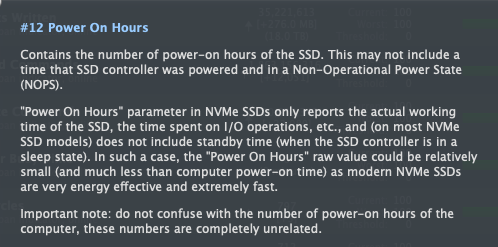Percentage Lifetime Remaining (Percentage Lifetime Used on PCIe)
This attribute is exactly as its name implies. It is a measure of how much of the drive’s projected lifetime is remaining at any point in time. When the SSD is brand new, Attribute 202 will report “100”, and when its specified lifetime has been reached, it will show “0,” reporting that 0 percent of the lifetime remains.
However, it’s important to realize what it means to use the projected lifetime – it does not mean that the drive is going to fail when that counter reaches zero, only that your SSD may need to be replaced soon.
The lifetime of a NAND-flash device is defined by another characteristic: data retention. Data retention is the amount of time that the device can safely store and allow successful retrieval of user data in an unpowered state. When an SSD or other NAND-flash device is brand new, its unpowered data retention will be several years. However, almost like human memory, it gets shorter as it experiences wear and tear, by writing data (data reads do not directly cause wear).
The Joint Electron Device Engineering Council (JEDEC) is the industry group which creates standards and specifications for semiconductor-based devices and assemblies. Micron is a leading member of JEDEC, which defines data retention in a specific way: For SSDs in client applications (like business or personal computers), data retention for an SSD shall be one year, in an unpowered state, stored at 30 °C (86 °F). This should give most computer users plenty of time to retrieve any data from an unused drive after some time on the shelf, if needed.
You might be able to tell from this description that the SSD can be expected to work quite well as the lifetime counter counts down from 100 percent. However, as time carries on, data retention will continue to degrade, down from one year to six months to three months, and so on. Eventually, long beyond the warrantied life of the drive, any new write will not be retainable at all while unpowered.
However, SSD firmware takes this into account. As the SSD continues to age, error correction code (ECC), read retries, adaptive read parameters, background data maintenance, and other adjustments in firmware can correct problems that arise because of gradually degrading data retention. As NAND data blocks degrade, they can be replaced by on-board spares, and normal operations can proceed. Of course, all these background operations take place when power is on, which is why data retention is defined in an unpowered state.
This attribute is also presented as "Percentage Lifetime Used" on certain legacy Crucial SSDs, as well as NVMe models, and works similarly to Lifetime Remaining, only in reverse. The new SSD's Attribute 202 will report “0”, and when its specified lifetime has been reached, it will show “100,” reporting that 100 percent of the lifetime has been used. On these models, the percentage can exceed 100 as more write operations are done, but the data retention concerns are the same.









